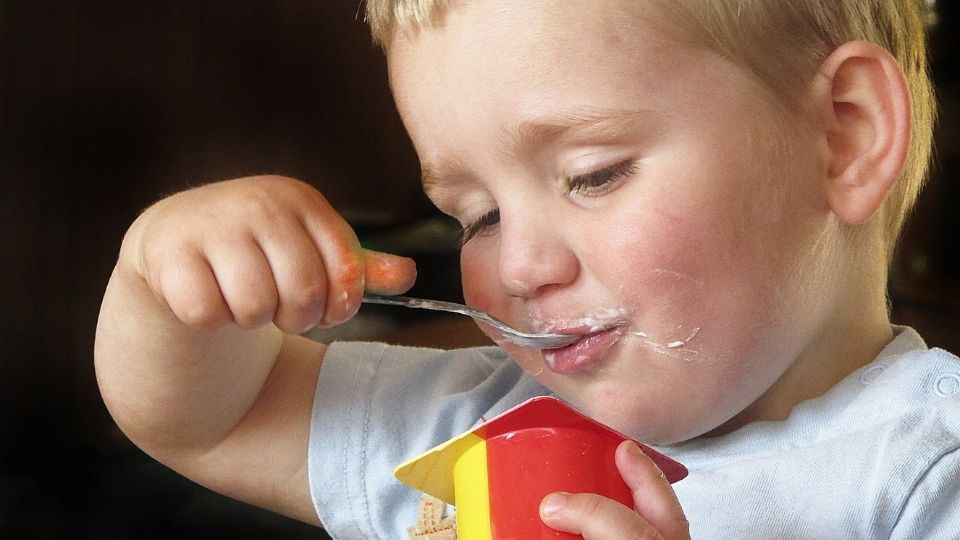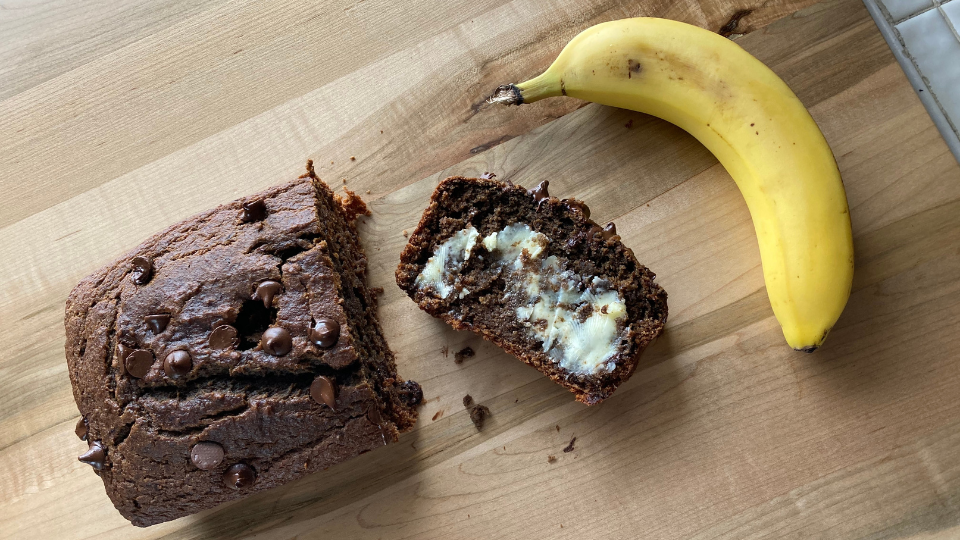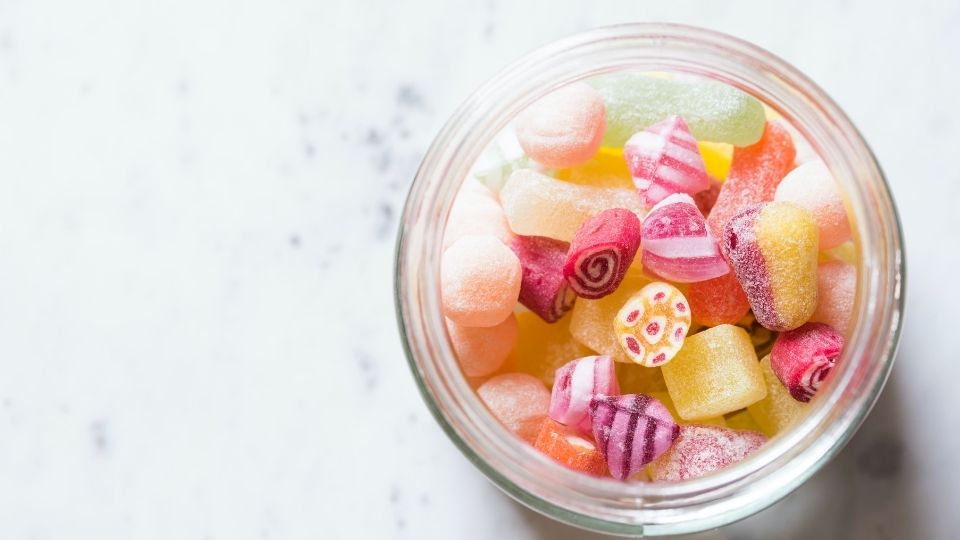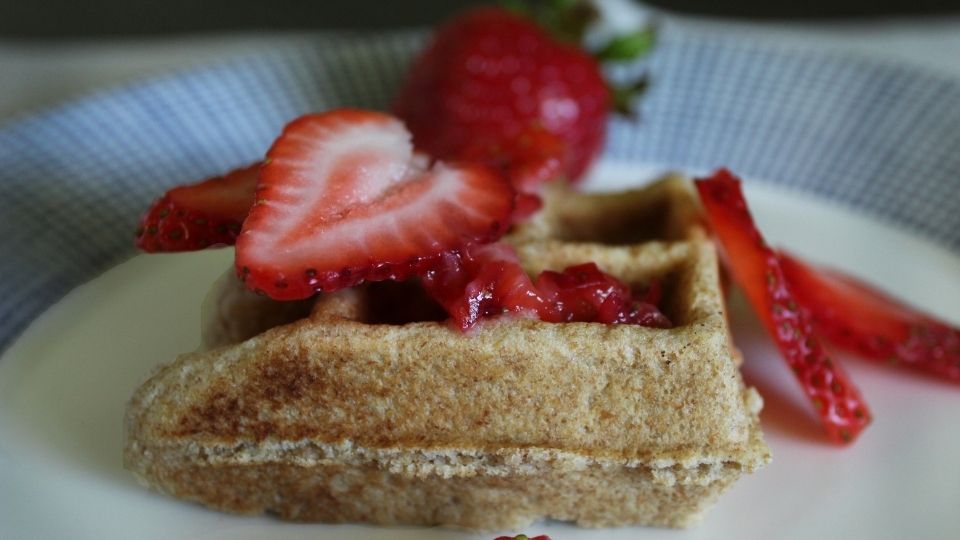Fresh and Easy: How to Make Pureed Baby Food

Starting the transition from breast milk or formula to solid foods can be quite daunting for parents.To add to the challenge, there are hundreds of commercial pureed baby food options on the market to choose from. In addition, commercial baby food can be expensive. Homemade pureed baby food is a great alternative since it is typically less expensive and more nutritious than commercial options. In fact, some parents prefer making pureed baby food, so they know exactly what is in the food they are feeding their baby. Making pureed baby food can be easy way to ensure your child is exposed to a wider variety of foods than what is available in commercially made options. In this fact sheet we will walk you through how to safely prepare and store pureed baby food so it is nutritious, convenient, and less expensive than store bought baby food.
Start Simple
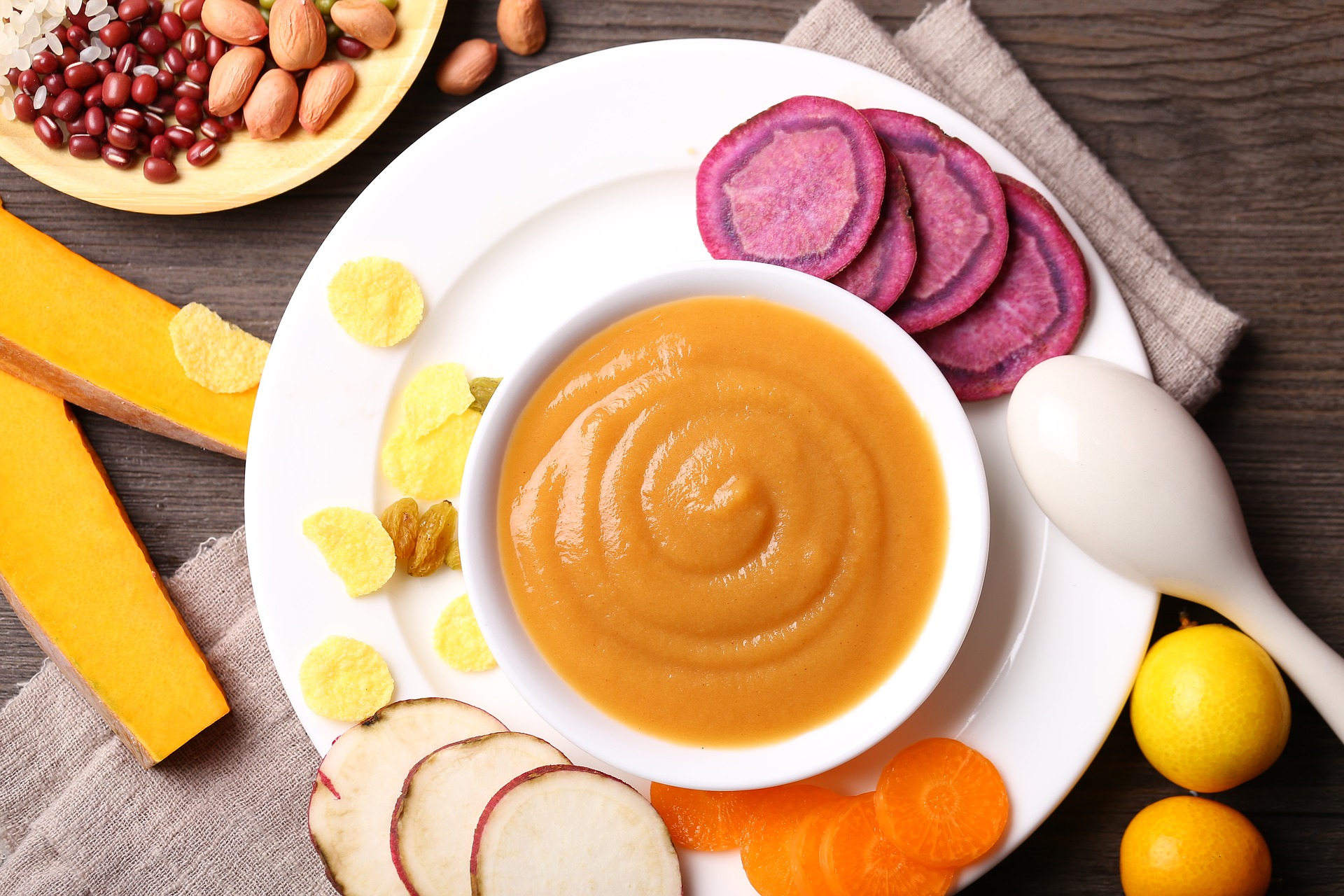
Start with one food at a time and select foods that are nutritious and easy to mash such as bananas, avocados, peaches, mangoes, plums, grapes, potatoes and butternut squash. If your baby responds well to these, advance to other nutritious foods such as asparagus, kale, ground chicken, or quinoa. Starting with one food at a time allows your child to adjust to different flavors and allows parents to easily determine if they are allergic to certain foods. Babies are naturally intuitive eaters, meaning they have a very good sense of how much food they need to eat at any given time. Do not encourage babies to eat more or less than they choose to. Look for signs that your child has had enough to eat, such as, turning their head away or spitting out food.
Preparing a Homemade Puree
Preparing pureed baby food may seem like a huge undertaking but it doesn't need to be. Many of the foods you eat with your family can be mashed up for baby to eat with you. Here are some tips on how to safely and easily prepare different foods for your infant:
- Fruits and vegetables: Wash, peel, and remove seeds that may cause choking. If using canned or frozen products be sure to check the ingredient list to avoid excess sugar and salt.
- Meats/fish/poultry: Remove all fat, skin and bones before cooking. Also remove any visibly tough parts. Meats, fish and poultry should be chopped/ground as fine as possible to prevent choking.
- Oatmeal: Grind oats to a fine powder using a food processor or blender and simmer in water. Use breast milk or formula to cook instead of other liquids. This makes the oatmeal even more nutritious for baby.
- Texture is important for babies when they are first eating solid foods. Cook the food until it is very tender, easy to mash, or can be eaten as finger food. Steaming is the best way to retain vitamins and minerals and achieve an appropriate texture.
- When preparing food for the family, remember to remove the baby’s portion before adding salt, sauces and other seasoning.
- Let food cool before feeding your baby. The food should be lukewarm (between 80-105° F) when you put it up to your lips.
Storing Pureed Baby Food
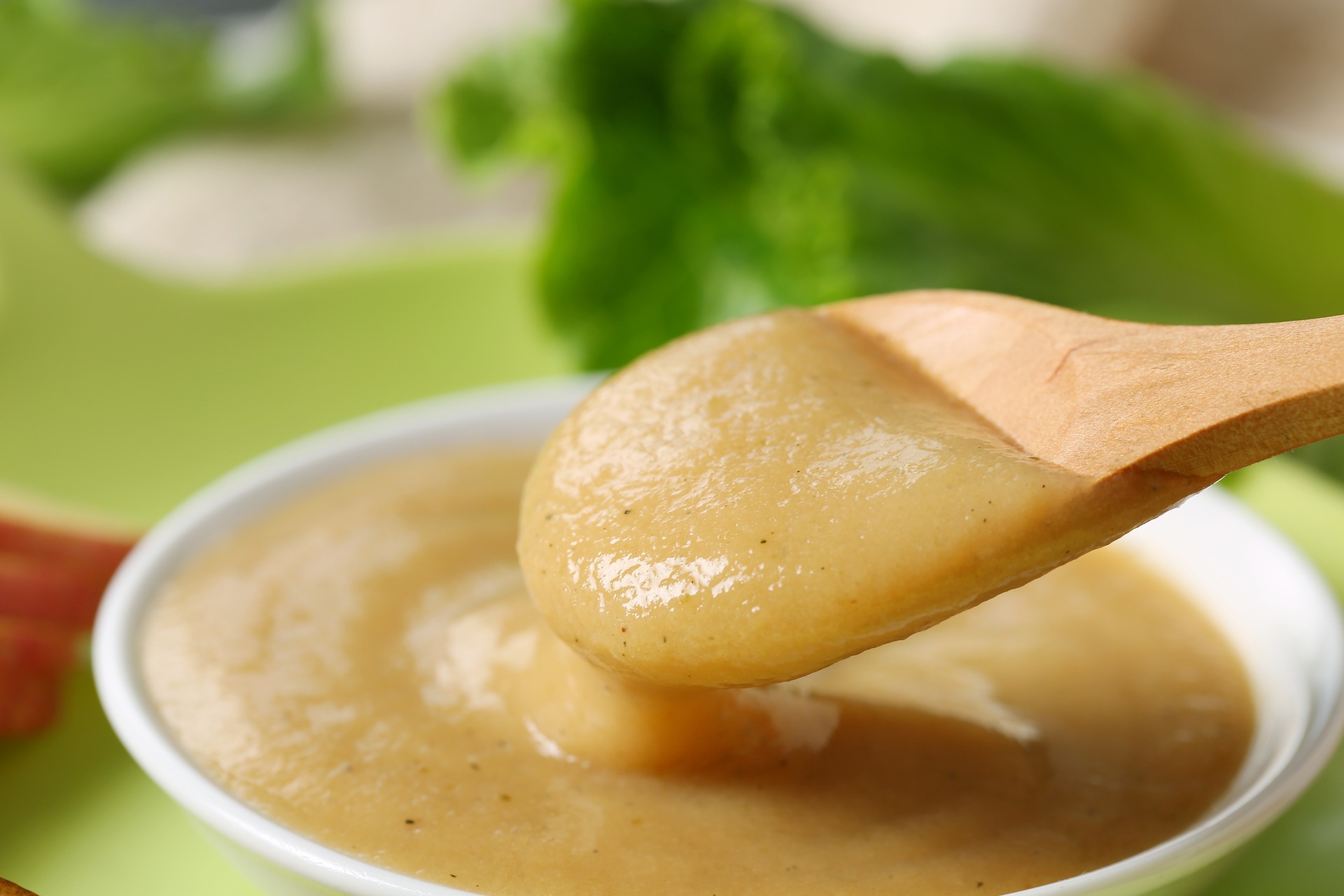
Properly storing pureed baby food is crucial to your baby’s well-being. Improper storage can result in the growth of harmful bacteria that can cause serious illness. The following storage and food safety recommendations are adapted from the USDA Home-Prepared Infant Food guidelines.
- Prepared pureed baby food should not be held for longer than 2 hours at room temperature.
- Refrigerate foods immediately after preparation. Ensure your refrigerator is consistently at a temperature of 40° F or lower to keep food safe.
- Keep foods in shallow airtight container and always label it with the date. Store for up to 2 days in a refrigerator or 3 to 4 months in a freezer. Meats should be used within 24 hours.
- Freeze in small portions. There are two recommended ways:
- Ice Cube Tray Method: Pour pureed food in a clean ice cube tray then cover with plastic wrap or foil until frozen. Once frozen place ice cubes in an airtight container.
- Cookie Sheet Method: Drop 1-2 tablespoons of pureed food onto a cookie sheet then cover with plastic wrap or foil until frozen. Once frozen, place drops of frozen pureed baby food in an airtight container.
- Thawing should be done in the refrigerator, under cold running water, or as part of the reheating processes. Never thaw pureed baby food at room temperature. Thawed portions that don’t get eaten should be thrown away, not refrozen.
Food Safety
While adult and child food safety procedures are the same, being attentive to food safety and sanitation is vital. Proper food safety helps prevent harmful bacteria from entering your infant’s food. Below are USDA recommendations for food safety.
- Lightly rub the produce under running water before you peel, cut, or puree it. For produce that is more firm such as melons you may want to use a clean vegetable brush. Cleaning produce prevents dirt and bacteria from entering your child’s food. Throw away produce that is moldy or bruised.
- Always have clean utensils, surfaces and hands. You should wash utensils and surfaces after each use. Wash your hands before, during, and after preparing food.
- Bacteria thrive in the mouth, once a spoon touches the mouth and then the food, the food shouldn’t be saved for later use.
- Separate raw meat from all other foods.
- Reaching appropriate temperatures are vital for preventing food borne illnesses. Always ensure any meat or fish is cooked to the proper temperature (Table 1). Use a clean food thermometer to check the temperatures of foods.
Table 1. USDA: Safe Minimal Internal Temperature Chart
| Beef, pork, veal, and lamb - Steak, chops, roasts | 145° F and allow to rest for 3 minutes |
| Ground meats | 160° F |
| Ham, fresh or smoked (uncooked) | 145° F |
| Fully cooked ham | Reheat to 165° F |
| Poultry - Breasts, whole bird, legs, thighs, wings, ground, stuffing | 160° F |
| Eggs | 160° F |
| Fish/Shellfish | 145° F |
| Casseroles | 165° F |
| Leftovers | 165° F |
What to Avoid
There are a handful of food and beverages that are unsafe to feed your baby. The table below explains why your infant shouldn’t consume these products.
Table 2: Foods and Drinks that Should Be Avoided by Infants until 1 Year Olds
| Food to Avoid | Reason | Explanation |
|---|---|---|
| Rice drinks | High arsenic levels Malnutrition | High arsenic levels can lead to decreased performance and developmental delays. Lack of calories, protein and fat in rice drinks can lead to malnutrition. An example of a rice drink would be rice milk or Horchata. |
| Honey | Botulism | Risk of clostridium bacterial spores which can cause infant botulism. |
| Cow, goat, and soy milk | Iron deficiency anemia | Risk of iron deficiency anemia and deficiency of other important nutrients found in breast milk and formula. |
| Water | Malnutrition | Water should not be used to replace breast milk or formula as it can result in malnutrition. Water is acceptable for infants when mixed in food or in small amounts for drinking in extremely hot weather. |
| Home canned foods | Botulism | Can be a botulism risk if not canned/processed correctly. |
Nutrient Comparison for Commercial Pureed Baby Food and Homemade Pureed Baby Food
Commercial and homemade purees each have their own strengths and drawbacks in regards to safety and nutrition. For example, commercial puree has been found to have more calories and vegetables per serving as compared to homemade. However, homemade purees typically have more protein per serving. Commercial baby food has been found to be a healthy, convenient option if chosen wisely. Combination commercial pureed baby foods (commercial baby foods that contain more than 1 food item) can be higher in starch, salt, and sugar. The American Academy of Pediatric Nutrition Handbook states that “food choices should be encouraged, whether home or commercial prepared, are those with no added salt or sugar”. Early exposure to sodium and sugar can set taste preferences for the child’s future. Be sure to check food labels of commercial baby food for lower amounts of salt, sugar, and higher amounts of protein.
Cost Savings
Commercial purees aren’t always the most cost effective options. The table below compares the prices of a single package of commercial name brand baby food and the amount of fruit or vegetable found on the top of the package to homemade.
Table 3: Price Difference in Commercial Pureed and Homemade Pureed Baby Food
| Commercial | Fruit/Vegetable per package | Price | Fresh | Homemade price |
|---|---|---|---|---|
| Apple package | 1/3 apple | $0.74 | Fuji Apple | $0.42 |
| Banana package | 2/3 banana | $0.49 | Banana | $0.36 |
| Pear package | 1/3 pear | $0.49 | Concorde Pear | $0.49 |
| Mango, pouch | 1/4 mango | $1.24 | Mango | $0.25 |
| Prunes package | 2 3/4 mango | $0.49 | Prune | $0.20 |
| Carrots package | 1 large carrot | $0.74 | Carrot | $0.20 |
| Green beans package | 14 green beans | $0.49 | Green Beans | $0.21 |
| Sweet Potato package | 1/2 potato | $0.44 | Sweet Potato | $0.15 |
| Pea package | 60 peas | $0.49 | Peas | $0.29 |
| Butternut Squash package | 1/4 cup cooked squash | $0.74 | Butternut Squash | $0.16 |
*Amount of fruit or vegetable per package was considered when calculating homemade price. Prices found at Walmart Online, April 11, 2018.
Give homemade pureed baby food a try! Having the hands-on experience of making your child’s puree will allow you to have confidence that your child in being fed nutritious and delicious foods. Why go to the store and buy a butternut squash puree when you’re already making a butternut squash for dinner? Mash it up, check the temperature, and you’re ready to go.
References
- American Academy of Pediatrics (2015). Working Together: Breastfeeding and Solid Foods. Retrieved from https://www.healthychildren.org/English/agesstages/baby/breastfeeding/Pages/Working-TogetherBreastfeeding-and-Solid-Foods.aspx
- California Department of Public Health (2010). Welcome to the infant botulism treatment and prevention program. Retrieved from http://www.infantbotulism.org/general/faq.php
- Carenco, J (2013). Bebe Gourment: 100 French-inspired baby food recipes for raising an adventurous eater. New York, NY: The Experiment.
- Carstairs, S. A., Craig, L. C., Marais, D., Bora, O. E., & Kiezebrink, K. (2016). A comparison of pre-prepared commercial infant feeding meals with home-cooked recipes. Archives of Disease in Childhood, 101(11), 1037- 1042. doi:10.1136/archdischild-2015-310098
- Center for Disease Control (2017) Prevention | Botulism Retrieved from https://www.cdc.gov/botulism/prevention.html
- Cogswell ME, Gunn JP, Yuan K, Park S, Merritt R. (2015). Sodium and Sugar in Complementary Infant and Toddler Foods Sold in the United States. Pediatrics. February 2015. doi:10.1542/peds.2014-3251
- . L., Yeung, D. L., (2012). Microbial safety, nutritive value, and residual pesticide levels are comparable among commercial, laboratory and homemade baby food samples – A pilot study. The Open Nutrition Journal, 6(1), 89–96. doi.org/10.2174/1874288201206010089
- Garcia, A., Raza S., Parrett, A., & Wright, C. (2013) Nutritional content of infant commercial weaning foods in the UK. Archives of Disease in Childhood, 98(10), 793-797.
- Griebler, U., Bruckmüller, M. U., Kien, C., Dieminger, B., Meidlinger, B., Seper, K., … Gartlehner, G. (2016). Health effects of cow’s milk consumption in infants up to 3 years of age: a systematic review and meta-analysis. Public Health Nutrition, 19(2), 293–307. doi.org/10.1017/S1368980015001354
- Hopsack, I., Braegger, C., Bronsky, J., Campoy, C., Colomb, V., Decsi, T., … ESPGHAN Committee on Nutrition. (2015). Arsenic in rice: A cause for concern. Journal of Pediatric Gastroenterology and Nutrition, 60(1), 142. doi.org/10.1097/MPG.0000000000000502
- Koluman, A., Gölcü, B. M., Deri̇n, O., Özkök, S., & Anniballi, F. (2013). Clostridium botulinum in honey: prevalence and antibiotic susceptibility of isolated strains. Turkish Journal of Veterinary & Animal Sciences, 37(6), 706–711. doi.org/10.3906/vet-1209-40
- Lockyer, S. (2016). Commercial vs. home-made baby foods - how do they match up nutritionally? Nutrition Bulletin, 41(4), 339-343. doi:10.1111/nbu.12236
- Mok, E., Vanstone, C. A., Gallo, S., Li, P., Constantin, E., & Weiler, H. A. (2017). Diet diversity, growth and adiposity in healthy breastfed infants fed homemade complementary foods. International Journal of Obesity, 41(5), 776-782. doi:10.1038/ijo.2017.37
- Maalouf, J., Cogswell, M. E., Bates, M., Yuan, K., Scanlon, K. S., Pehrsson, P., … Merritt, R. K. (2017). Sodium, sugar, and fat content of complementary infant and toddler foods sold in the United States, 2015. The American Journal of Clinical Nutrition, 105(6), 1443–1452. doi.org/10.3945/ajcn.116.142653
- Randhawa, S., Kakuda, Y., Wong, C. L., Yeung, D. L., (2012). Microbial safety, nutritive value, and residual pesticide levels are comparable among commercial, laboratory and homemade baby food samples – A pilot study. The Open Nutrition Journal, 6(1), 89–96. doi.org/10.2174/1874288201206010089
- Satter, E. (1987). How to get your kid to eat…but not too much. Boulder CO: Bull Publishing Company.
- Satter, E. (2000) Child of mine: feeding with love and good sense. Boulder Co: Bull Publishing Company.
- United States Department of Agriculture (2017). Infant Nutrition and Feeding. Retrieved from https://wicworks.fns.usda.gov/infants https://wicworks.fns.usda.gov/wicworks/Topics/FG/Chapter 5_ComplementaryFoods.pdf
- United States Department of Agriculture (2015). Safe minimum internal temperature chart. Retrieved from https://www.fsis.usda.gov/wps/portal/fsis/topics/food-safetyeducation/get-answers/food-safety-fact-sheets/safe-foodhandling/safe-minimum-internal-temperature-chart/ct_index
Authors
Shayla Shearer Dietetics Student; Mateja R. Savoie-Roskos PhD, MPH, RD; Carrie Durward PhD, RD;
Related Nutrition Articles



